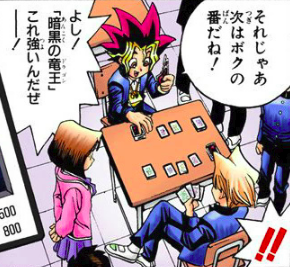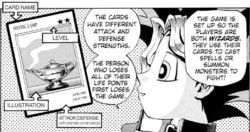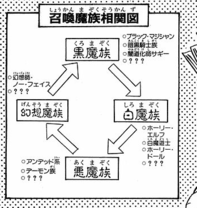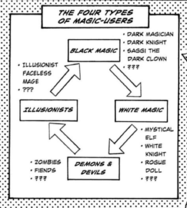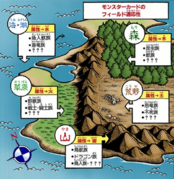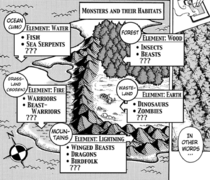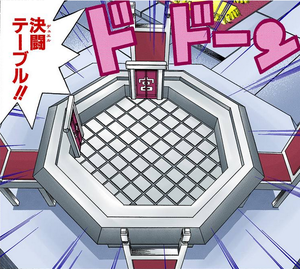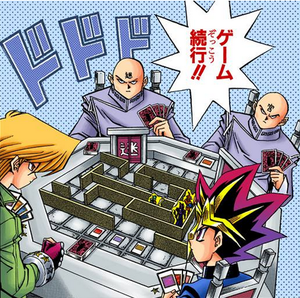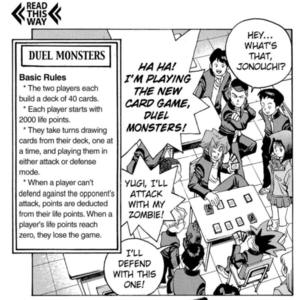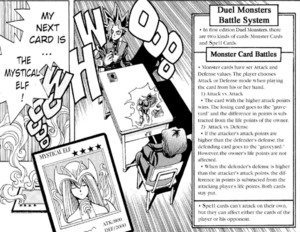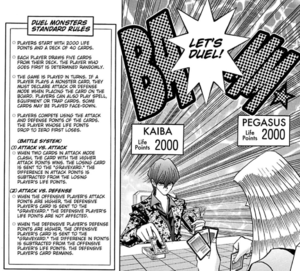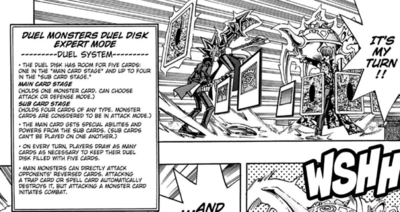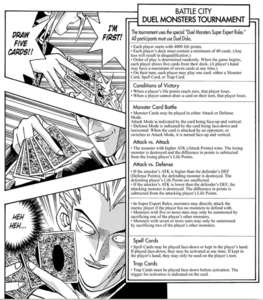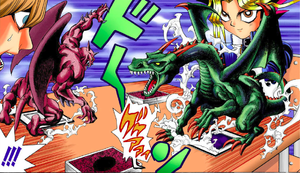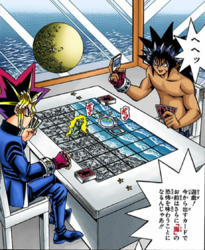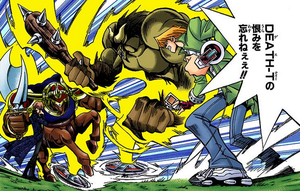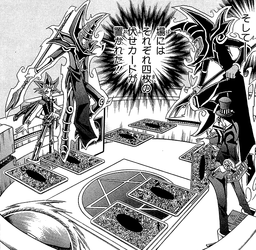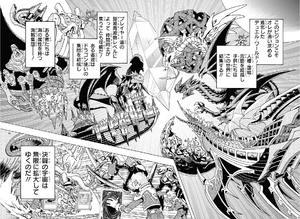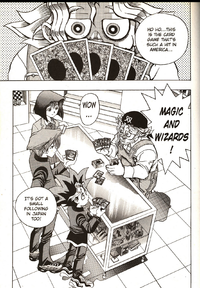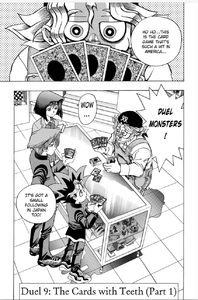Duel Monsters (manga)
Duel Monsters, known as Magic and Wizards (マジック
This is the very first incarnation of Duel Monsters and served as the basis for many of the variations to follow, including the Yu-Gi-Oh! Official Card Game and Yu-Gi-Oh! Trading Card Game.
Duel Monsters debuted when the manga had an episodic format and featured a different game nearly every week. However due to its popularity among readers, it ended up becoming the main game played throughout the series.
In-universe, Duel Monsters was invented by Maximillion J. Pegasus, as a means of reintroducing Diaha, battles played in ancient Egypt using monsters sealed in stone slabs, to the modern world.
Contents
Rules
Types of cards
The types of cards are:
- Monster Card[1]
- Spell Card[1]
- Trap Card[2]
- Equip Card[3]
- Illusion Card[4]
- Virus Card[5]
- Slot Machine Power Unit[6]
It is possible for a card to have multiple card types. e.g. "Graverobber" is a Trap/Spell Card.[6]
Non-game cards exist, such as "Soul Prison" and the Invitation Cards. These cards are not intended for use in Duels.
Monster Cards
Monster Card have the following properties, which are printed on the card:
- Level
- A rough indicator of the monster's overall strength. In the Super Expert Rules, it is used to determine the number of Tributes needed to Summon it.
- ATK and DEF
- Used in determining battle outcomes and damage calculation
- Effect
Monsters also have the following properties, which are not printed on the card:
Family
Family (系), unnamed in the English manga, was a division of monster.[1] It might be a common term, referring to both Type and Attribute, as all families are also demonstrated to be Types or Attributes.
The following families are mentioned:
- Attributes:
- Types:
- Beast-Warrior (
獣 戦 士 )[1] - Undead (アンデット)[1][7] As a Type, the English manga refers to it as "Zombie".[4]
- Demon Magic (
悪 魔 , called "Fiend" in the English manga)[1] As a Type, the English manga refers to it as "Demon" and "Devil".[4] - Black Magic (
黒 魔 , called "Spellcaster" in the English manga)[4] - Warrior (
戦 士 )[10][11][12] - Knight (
騎 士 )[11]
- Beast-Warrior (
Attribute
An Attribute (
Monsters can have the following Attributes:
- Earth (
土 )[13] - Lightning (
雷 )[7][13] - Water (
水 )[7][13][14][15][16] - Fire (
火 [13], later炎 literally "Flame"[11][17][18]) - Wood (
木 ),[13] later called Forest (森 )[19] - Light (
光 )[20][21] - Dark (
闇 )[22][23][5][20][24]
A monster can have multiple Attributes.[23][17][note 1]
Attributes can be strong and weak against other Attributes. What happens when monster of opposing Attributes battle is inconsistent. Sometimes the monster of the weaker Attribute loses half its ATK.[7] Sometimes the weaker monster loses 300 ATK.[17][15] More often, nothing happens.
- Lightning is strong against Water.[7][15]
- Water is strong against Fire.[15]
- "Battle Ox" is strong against Fire.[17]
If monsters of incompatible Attributes are fused, for example a Light and Dark monster are fused, Attribute repulsion (属性反発) occurs and the Fusion Monster corrodes,[20] causing it to lose ATK equal to that of the weaker fusion material monster each turn.[25]
Type
Type (族) is another division of monster. In the English manga, Type is sometimes called "Class".[22]
The following Types exist:
- Magical Knight (
魔 導 騎 士 , called "Warrior" in the English manga[22], which is also the name of a different Type[13]) - Dinosaur (
恐 竜 )[2][13] - Dragon (ドラゴン,[7][13][26] sometimes
竜 [27]) - Beast (
獣 )[7][13][28] - Magic-User (
魔 )[28]- Black Magic (
黒 魔 )[4] - White Magic (
白 魔 )[4] - Demon Magic (
悪 魔 , split into "Demon" and "Devil" in the English manga)[4] - Illusion Magic (
幻 想 魔 , called "Illusionist"[4] or "Illusion"[29] in the English manga)
- Black Magic (
- Dark Knight (
暗 黒 騎 士 )[4] - Daemon (デーモン, called "Fiend" in the English manga.[4] Although "Fiend" was also used for "Demon Magic", 悪魔.)
- Zombie (アンデット, literally "Undead")[4]
- Insect (
昆 虫 )[13] - Immortal (
不 死 , English manga mentions "Zombie" in its place.[13]) - Winged Beast (
鳥 獣 )[13] - Birdfolk (
鳥 人 )[13] - Wild Beast (
野 獣 , English manga mentions "Beast-Warrior" in its place)[13][10] - Warrior (
戦 士 )[13][28] - Knight (
騎 士 , English manga groups "Warrior" and "Knight" together as "Warrior")[13][27][28] - Fishman-Beast (
魚 人 獣 , English manga mentions Fish in its place)[13] - Sea Serpent (
海 竜 )[13] - Machine (
機 械 [27], later機械 )[24] - God (
神 )[30]- The term "God-Beast" (
幻 神 獣 ) has been mentioned in the context of the Egyptian Gods, without specifically mentioning "Type".[31] Despite having a dedicated Type, one of the God cards, "Slifer the Sky Dragon", was said to be Dragon-Type, affecting the ATK of "Buster Blader".[32]
- The term "God-Beast" (
In the Standard Rules:
- Fire-Family is strong against Beast.[7]
- Fire-Attribute is strong against Dinosaur.[11]
- Black Magic is strong against White Magic.[4]
- White Magic is strong against Demon Magic.[4]
- Demon Magic is strong against Illusion Magic.[4]
- Illusion Magic is strong against Black Magic.[4]
Other classifications
Other classifications of Monster Cards are mentioned without specifying if they are considered to be Types, Attributes, or something else.
These include:
Non-Monster Cards
Non-Monster Cards have the following details printed on them:
Non-physical cards
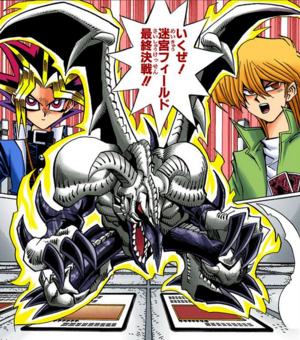
Some cards do not exist in a physical form, but are the result of the effects of other cards. e.g. "Thousand Dragon" is "Baby Dragon" affected by "Time Wizard". It does not possess its own dedicated card, but has its own name, ATK and DEF.
Fusion Monsters are examples of non-physical cards.[35]
The original monster or monsters that a non-physical monster is a form of will remain on the field. For example if a player forms "Black Skull Dragon" by fusing "Red-Eyes Black Dragon" and "Summoned Skull", the physical "Red-Eyes Black Dragon" and "Summoned Skull" cards remain on the field, but will not exist as separate monsters. They will just act as the unified "Black Skull Dragon".[35][25][note 2]
Card effects
Some monsters and all non-monsters have effects that can influence gameplay. Not all cards with effects have their effects printed on them. Printed effects are not always complete or written in a manner than clarifies the precise technicalities of the effect.
In the English manga, printed effects often contain translation errors or show the effect the card has in the Yu-Gi-Oh! Trading Card Game, which is often different than the card's effect in manga.
Fields
Different zones that monsters are played in can have different fields.
Monsters received Field Power Sources depending on the terrain they were played in.[36]
- Forest (
森 ) strengthens the Wood Attribute and the Insect and Beast Types.[13] - Grassland, also known or Sogen (
草 原 ) strengthens the Fire Attribute and the Wild Beast, Warrior, and Knight Types.[13] - Mountains (
山 ) strengthens the Lightning Attribute and the Winged Beast, Dragon, and Birdfolk Types.[13] - Wasteland (
荒 野 ) strengthens the Earth Attribute and the Dinosaur and Immortal Types.[13] - Ocean also known as Sea (
海 ) strengthens the Water Attribute and the Fishman-Beast and Sea Serpent Types.[13] - Graveyard (
墓 場 ) strengthens Ghost cards.[12]
A monster benefiting from a Field Power Source gains increases its ATK[13] and DEF by 30%[37] This is applied after increases from other cards. e.g. A monster with 500 ATK equipped with a card that causes it to gain 1500 ATK with have 2600 ATK; (500 + 1500) × 130% = 2600, not 500 × 130% + 1500 = 2150.[13]
A monster benefiting from a Field Power Source wins initiative in battles.[13]
Monsters benefiting from the Ocean terrain can be played underwater or on the surface.[38][14] and cannot be attacked by land-dwelling monsters.
During the Duelist Kingdom tournament, these fields were automatically in effect, depending on what area of the island players Dueled in.[36] But monsters could not gain their Field Power Source at nighttime.[39]
Field Spell Cards can be used to change the field.[40] Other cards have effects that can change portions of the field.[37][note 3][note 4][note 5][note 6]
Position on the field
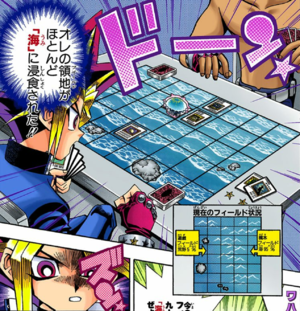
This field is 95% Sea and 5% Wasteland.
Ryota Kajiki has "Leviathan" in his back row, "Jellyfish" and "Devil Kraken" in his front row. His monsters hidden under the sea are lacking projections.
Dark Yugi has "Mystical moon" in his front row. (Before its destruction, "Silver Fang" was in the same zone as "Mystical moon".)
Each player can Summon monsters to their own side of the field into a designated zone. In the Standard Rules, the game is played on an 8×5 board,[14] later an 8×6 board.[41] The Deck and Graveyard are placed outside of this grid and players can play cards in the zones in the two rows of eight nearest them.[14]
Each zone can have a different field in effect. When two monsters battle, they can each receive Field Power Sources from their respective zones.
A player can move a monster to another zone if there is a path of unobstructed zones. This includes moving monsters into the opponent's territory.[14][note 7] A player can put multiple monsters in the same zone.[42][note 8] Upon losing its airborne nature, a monster could collapse onto ground-based cards in the same zone as it, destroying them.[42]
If a monster is in a zone between an attacking monster and its target, the monster in the middle will obstruct and become the new attack target.[43] This only applies if within range. e.g. a ground-based monster will not obstruct a battle between two airborne monsters.[42][note 9]
There are cards with effects that can prevent cards from moving.[43]
When using Duel Disks, the concept of the field is different. Having just five zones per player and no grid, many of the above rules are not applicable.[44]
Hiding monsters
A monster can be played in an environment that makes it hidden. This includes:
- Aquatic monsters played in the Sea terrain[38][18]
- Monsters played in the darkness cast by "Castle of Dark Illusions"[39]
- Tunneling monsters in a terrain that can be burrowed[18]
- Monsters played inside "Toon World"[33]
When playing a monster in such an environment, the player may choose to make it hidden or not.
A hidden monster is generally out of range of attacks. But effects may be used to allow other monsters to reach them.
- Lightning-Attribute attacks can be used on bodies of water to attack monsters hidden inside.[14]
- Effects that illuminate the field, such as "Swords of Revealing Light" can expose monsters hidden in darkness.
- Fire attacks can be used to momentarily illuminate the darkness, but cannot attack a monster at the same time.[39]
- "Salamandra" gives monsters the ability to attack underground monsters if within range of an entrance to their tunnel.[18][note 10]
- Monsters hidden inside "Toon World" can be attacked by other Toon cards.[33][note 11]
Movement and attack types
Monsters movement types include:
- Flying
- Swimming
- Tunneling
- Ground unit
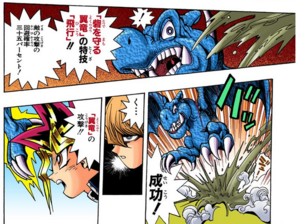
These affect how monsters can move, attack, and evade:
- Monsters capable of flying have a 35% chance to evade when attacked by a monster using a ground-based attack.[22] Later instances of this rule do not mention the 35% chance.[45][10][note 12]
- Flying monsters cannot move through dungeons, such as the Labyrinth, due to the ceiling.[28][note 13]
- Monsters capable of swimming can be hidden when played in the Sea terrain.[38][18]
- Ground unit monsters may move through dungeons, such as the Labyrinth.[28]
- Monsters capable of tunneling can be hidden underground in the Labyrinth, where they cannot be attacked. They leave a tunnel behind wherever they move.[18]
Warrior, Knight, Magic-User, and Beast-Type are examples of monsters that are typically ground units.[28][note 14]
Attacks may have special natures:
- Monsters capable of electric attacks can attack monsters in areas they cannot normally reach if the area has been dampened and gain an ATK boost in doing so.[45][15][note 15]
- Monsters capable of electric attacks can attack all monsters within a body of water at once.[14][note 16]
- "Jellyfish" is capable of absorbing electrical attacks, increasing its ATK and DEF.[14]
- Some Machine monsters have full-metal anti-magic armor which makes them immune to magical attacks. i.e. they cannot be destroyed by battle and their controller takes no battle damage from magical attacks.[24]
Sequence of play
Setup
- There are two players in each Duel.[46]
- Each player begins with 4000 Life Points.[47] (2000 before the Super Expert Rules[46])
- Each player's Deck contains 40 cards.[46] The Decks are shuffled before a Duel.[48]
- The field is laid out such that each player has space for their Deck, Graveyard and cards in play. When played on a flat surface, typically each player's Deck is placed on their right-hand side, Graveyard on the left-hand side, cards in play are placed in between.[46] Varieties exist where the Graveyard is out of sight[1] or both Graveyards are on the same side.[13] Duel Disks have designated slots for the Deck, Graveyard and five cards in play.
- At the beginning of a Duel, each player draws five cards, which become their hand.[22]
Turns
Each turn the turn player draws one card from their Deck.[46] A player's hand cannot contain more than seven cards[47]
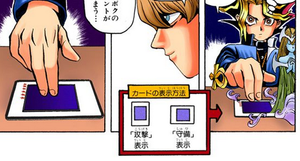
During their turn, a player can:
- Summon a monster from their hand in face-up Attack or Defense Mode.[46] Attack Mode is vertical. Defense Mode is horizontal.[1]
- In the Standard Rules, Monster Cards could be played face-down. Although this practice was only demonstrated once.[7] In the Super Expert Rules, Monster Cards cannot be played face-down. It is considered an illegal move to play a card face-down without first looking at it to determine if it is a monster or not.[49]
- Activate cards from their hand (other than Monster or Trap Cards)
- Play a non-Monster Card from their hand face-down.[1]
- Change the battle position of a monster.[22]
- The same monster cannot change its battle position more than once per turn.[50]
- Attack with Attack Mode monsters.[1]
In the Standard Rules, if a player does not have a monster on their side of the field at the end of the their turn, they can play one from their hand in Defense Mode.[22][37]
During their opponent's turn, a player can:
- Activate cards they played face-down.
Playing monsters
Each turn the player can Summon a monster from their hand.
Beginning with the Super Expert rules, monsters of Level 5 or higher require sacrifices to be Summoned.
- Level 5 and 6 monsters require one sacrifice.[47]
- Level 7 or higher monsters require two sacrifices.[47]
- God cards require three sacrifices.
Monsters can be Summoned by the effects of other cards. Sacrifices are not required when Summoning monsters this way.
Monsters can be fused together using the card "Polymerization".[45] "Polymerization" and the Fusion Material monsters are still in play after a Fusion. The Fusion Monster does not have a physical card.[25] Monsters cannot attack the turn that they are fused.[25][47]
Ritual Spell Cards can be used to play a monster by sacrificing monsters that meet a certain criteria. Some Rituals such as "Black Luster Ritual" sacrifice monsters to upgrade another monster.[52] Others such as "Black Illusion Ritual", Ritual Summon a new monster.[29] The Ritual Monster does not possess a physical card.
Attacking
A battle is conducted when the turn player announces for one of their Attack Mode monsters is to attack an opponent's monster.
- If an Attack Mode monster battles another Attack Mode monster, the monster with the lower ATK is destroyed and its controller loses Life Points equal to the difference.[1]
When Attack Mode monsters with equal ATK battle, both are destroyed.
- If an Attack Mode monster attacks a Defense Mode monster and its ATK is higher than the defending monster's DEF, the defending monster is destroyed and no Life Points are lost.[1]
- If an Attack Mode monster attacks a Defense Mode monster and its ATK is lower than the defending monster's DEF, neither monster is destroyed and the controller of the attacking monster loses Life Points equal to the difference in the ATK and DEF.[1]
If an attack is evaded (e.g. a flying monster dodges an attack from a ground-based monster or a non-Toon monster attacks a Toon monster), the attacked monster may still counter attack. It will not be destroyed in the two monsters have the same ATK. The monster that attacked it loses its Field Power Source.[10][53]
If a monster in a battle wins initiative, (e.g. by being in a field that they benefit from) the other monster loses increases to ATK and DEF and uses its original ATK and DEF for the duration of the battle.[13]
Monsters destroyed by battle go to the Graveyard.[1]
In the Super Expert Rules, monsters can attack the opponent directly if the opponent has no monsters to defend with,[47] in which case the opponent loses Life Points equal to the ATK of the attacking monster.[54] Direct attacks are not allowed in the Standard Rules.[41]
A player may attack and destroy their own Spell Card. No Life Points are lost in doing so.[14]
Victory conditions
A player is considered the winner if:
- They reduce their opponent's Life Points to 0.[46]
- Their opponent cannot draw a card when they are required to.[51][47]
- They use the effect of a card that makes them the winner, such as "Exodia the Forbidden One"[55] or "Destiny Board".[56]
- Their opponent surrenders. A surrender is announced by placing one's hand over their Deck.[52]
Variant Duels
Labyrinth Duel
A Labyrinth Duel is played on a 9×9 grid with a number of squares removed from each corner.[27] When "Labyrinth Wall" is played, it is placed outside of the grid. It causes walls to be added along some of the squares, and a ceiling to be added over them, restricting movement as monsters cannot move through walls or the ceiling. For convenience, the ceiling is not visible to the players[57][28]
- Monsters in Attack Mode can move a number of square equal to their Level.[57]
- When a monster moves, its card remains in the square it was originally played in, while the monster itself is whatever square it was moved to. When playing with holograms, a monster's current position is marked by its hologram.[28]
- Monsters must be in an adjacent squares in order to battle.
See the Movement and attack types section for details on how monsters can move in the Labyrinth.
Two teams sitting at opposite sides; Meikyû Brothers (background), Jonouchi and Dark Yugi (foreground)
The card "Labyrinth Wall" is placed outside the grid.
Jonouchi and Dark Yugi have three cards in the second row from them. The monsters from those cards have moved further into the board.
Tag Duel
Each team of two sits on opposite sides of the board[27] and plays cards in the two rows nearest them. The sequence of turns is as follows: Team 1 Player A → Team 2 Player A → Team 1 Player B → Team 2 Player B.[57]
Rule sets
Standard
The Standard Rules (スタンダード・ルール Sutandādo Rūru) are the basic set of Duel Monsters rules.
Only rules to feature or mention:
- Attributes being strong or weak against other Attributes
- Fields with Field Power Sources being active by default (later rules have them set by card effects)
- Monsters can be played in face-down Attack Mode[7]
Rules explained in Yu-Gi-Oh! Duel 9: "The Cards with Teeth (Part 1)"
Rules explained in Yu-Gi-Oh! Duel 10: "The Cards with Teeth (Part 2)"
Rules explained in Yu-Gi-Oh! Duel 108 (Duelist Duel 49): "The First Stages of Fear!"
Expert
The Expert Rules (エキスパート・ルール Ekisupāto Rūru) were used with the first version Duel Disks. This alters many of the previous rules and adds more.
Only rules to feature or mention:
- Each player can only hold five cards at a time.[25]
- If a player has five cards at the start of their turn, they cannot draw a card.[25]
- If a player has fewer than five cards at the start of their turn, they draw until they have five.
- A player's field contains five stages; the main card stage and four sub card stages. The main card is played in the main stage. All the player's other cards in their hand are played in the sub stages.[5]
- Monsters in the main monster can be played in Attack or Defense Mode. Monsters in the sub stages are all in Attack Mode.[5]
- The main card gets special abilities and powers from the sub cards.[5]
- Sub cards are face-down until used or attacked.[5]
- Sub cards can be flipped face-down and shuffled.[5]
- A player's main monster can attack their opponent's main monster or any of the opponent's face-down cards. Normal rules of battle are applied if they attack a Monster Card. Non-Monster Cards are automatically destroyed if they are attacked.[5]
Super Expert
The Super Expert Rules (スーパーエキスパート・ルール Sūpā Ekisupāto Rūru) were introduced in the Battle City tournament. They are based on the Standard Rules, contain additional rules and alter previous ones. The Expert rules do not apply in Super Expert.
Changes:
- Starting Life Points are changed from 2000 to 4000.[47]
- Direct attacks are allowed.[47]
- Sacrifice Summons are introduced.[47]
Rules explained in Yu-Gi-Oh! Duel 153 (Duelist Duel 94): "Duel of Vengeance!"
Realistic projections of cards
Multiple methods have been used to create lifelike projections of the cards while playing Duel Monsters.
- Cards have been brought to life by Millennium Item holders through use of Shadow Games.[46] The Shadow Game's players can see the conjured monsters or effects of cards,[46][58] but spectators cannot.[59]
- KaibaCorp used holographic technology to create projections of cards to artificially replicate the experience of the Shadow Games. This was mainly done through the use of Virtual Simulation Battle Boxes.[60]
- KaibaCorp later invented Solid Vision, which created even more realistic and life-sized projections of the cards. And invented Duel Disks as as a means of creating the projections from cards. The Duel Disks have a hyper 3-D engine built which processes the graphic data of the card at high speed to create Solid Vision using the V-2 emulator.[44][61] Despite Solid Vision also being holograms, players feel like they experience pain when attacked by Solid Vision monsters.[54]
- KaibaCorp also invented the Neurons as a means of playing Duel Monsters in the Duel Links virtual reality.[62]
Monsters in a Shadow Game
Holograms in a Virtual Simulation Battle Box
Solid Vision projections from the prototype Duel Disks
Virtual reality created using Neurons
History
Egyptian Diaha
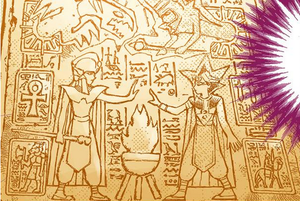
In ancient Egypt, it was believed that misfortunes were caused by evil spirits dwelling inside people. In order to bring peace, the Pharaoh's magicians tamed such spirits, gave them names and physical forms, and trapped them in stone slabs. While sealed the monsters slowly became more powerful. Eventually a group of Priests acted against the Pharaoh and harnessed the power of the stone slabs, using them to and summon the monsters from the tablets to fight in battles, known as Diaha.[63]
The magicians eventually died out and the stone tablets fell asleep deep below the earth. The legend was recorded in the Book of Thoth and passed down from generation to generation. All card games were said to have sprang from this source.[29]
Creation
Maximillion J. Pegasus became interested in the ancient Egyptian beliefs in life after death, following the death of his lover, Cyndia. This led him to Egypt to learn more.[64]
At the village, Kul Elna, Pegasus failed to bargain with Shadi for the safety of a a thief who was to persecuted for his attempt to steal the Millennium Ring. Pegasus spied on the thief being put on trial to see if he was chosen by the Ring. However the Ring rejected the thief as a host, burning him to death in the process. Pegasus was caught spying on the ritual and not permitted to leave unless he became bearer of a Millennium Item. For his trial, Pegasus had his left eye was cut out and the Millennium Eye inserted into in its socket. The Eye accepted Pegasus and showed him an apparition of Cyndia.[64]
In the Valley of the Kings, Pegasus heard the legends of the Egyptian magicians that battled using the monsters sealed in tablets. He created Duel Monsters as a means of bringing the ancient games to the modern world,[29] an act Ishizu Ishtar claimed he was led by fate to do.[31]
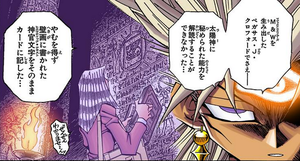
Pegasus based a number of cards on images he saw on stone carvings. This included the three Hidden Gods of Egypt depicted on the Tablet of Lost Memories, each of which he designed as a one-of-a-kind card.[31] The Sun Dragon Ra had its abilities carved into a tablet in hieratic text. Unable to translate them, Pegasus resigned to simply transcribing the hieratic text directly onto the card, leaving him unaware of its effects. He used a special kind of ink that would only be visible in the light emitted by Ra.[65] It was said that whoever acquires the three God cards would be given the title of "Duel King". However the cards gained great power as if the Gods actually resided in them and were capable of taking an opponent's life. Pegasus regretted their creation, considering it to be his greatest mistake. He tried to physically destroy the cards, but could not bring himself to do it, and opted to have them buried within the Valley of the Kings, where they had come from.[31]
The card "Blue-Eyes White Dragon" was based on The White Dragon seen on the Tablet of Lost Memories.[31] It was initially considered to be one of the most powerful cards, so overpowered that production was ceased, causing it to gain a high monetary among collectors.[46] Four copies were known to exist. They fell into the hands of collectors in the United States, Germany, and Hong Kong and Sugoroku Mutou in Japan.[60]
Rise in popularity
Duel Monsters became a huge success in the United States, with players said to be in excess of twenty million and many tournaments hosted with large prizes.[66]
The game features a number of valuable cards, with one fan in America alleged to have sold his house to pay for a single card.[46]
By the time of Death-T, Duel Monsters was considered to be the world's #1 collectible card game.[60]
Introduction of holograms
Seto Kaiba's attempt to steal the "Blue-Eyes White Dragon" from Sugoroku Mutou resulted in him being challenged to a Shadow Game of Duel Monsters by Dark Yugi. In this game, the monsters came to life as they were Summoned.[46] On defeat, Kaiba was subjected to a Penalty Game, resulting in him imagining he was trapped inside a card, causing him to reside in the World of Duel Monsters, where he suffered the Experience of Death at the hands of monsters.[1]
Kaiba invented the Virtual Simulation Battle Boxes, which created 3-D holograms of cards, as players played Duel Monsters, recreating what he witnessed in the Shadow Game. And allowed him to inflict a reconstruction of the Experience of Death on the loser.[60]
Kaiba's company, KaibaCorp, sent an offer to Pegasus to develop Virtual Simulation Battle Boxes together with Industrial Illusions, to enhance the experience of playing Duel Monsters. Pegasus described it as a great idea and said that he would love for their companies to develop it together.[66]
Battle Boxes were used during Death-T and Duelist Kingdom.
Introduction of Solid Vision
Duel Disks were developed later by KaibaCorp as a more upgraded means of Dueling that the Battle Boxes. Kaiba was in some part incentivized to develop them having witnessed the mind-reading abilities that the Millennium Eye granted Pegasus. The Duel Disks required players to stand at least 5 meters apart, which Kaiba hoped would be enough to put him out of Pegasus' Mind Scan's range. Unlike Battle Boxes the Duel Disks used Solid Vision, which created life-sized projections[44] and were considered to be much more realistic than the holograms used by the Battle Boxes.[61]
Pegasus was fond of the Solid Vision technology as it was capable of creating projections that were more lifelike than simple holograms. He hoped to takeover KaibaCorp, so he could have the technology and make it even more lifelike and create a realistic reconstruction of Cyndia, whom he had created a card of.[61]
Real-world information
Name
The game is called Magic and Wizards or M&W for short in the Japanese manga. However, due to its similarity to Magic: The Gathering, the game was renamed to Duel Monsters in other media. Despite this, the Japanese manga continued to call the game Magic and Wizards throughout its run.
When the English manga was first printed in the Shonen Jump magazine, it used the name Magic and Wizards.[46] This name was also used in the first printing of the graphic novels. In subsequent reprints, the name was changed to Duel Monsters.
Design
The Yu-Gi-Oh! manga originally featured many different games, which rarely appeared more than once. Duel Monsters was initially meant to only feature in two chapters.[67] However, Shueisha, the publisher of the Weekly Shōnen Jump magazine, received so many letters and fan-mail asking about the game that Kazuki Takahashi was encouraged to extend it.[68]
Takahashi came up with the original rules for the game in a single night.[67] The idea for holograms and Solid Vision was inspired by Dejarik, a board game in Star Wars that featured holographic pieces.[69]
Adaptations
- The Yu-Gi-Oh! anime by Toei Animation featured a version of Duel Monsters, based on the manga game. It first appeared April 18, 1998. The game was renamed from Magic and Wizards to Duel Monsters for this medium. Although the card backings featured the letters "MW".
- The Yu-Gi-Oh! Cardass by Bandai, first released August 1998, is based on the manga game.
- The Yu-Gi-Oh! Duel Monsters video game by Konami, released December 16, 1998, and a number of its sequels features a Duel Monsters game, based on the one from the manga. The series uses the name Duel Monsters. Although the game is called Magic at one point in dialogue.
- The Yu-Gi-Oh! Official Card Game (OCG) by Konami, first released February 4, 1999, incorporated elements from the manga game and the video game. Its logo features the term Duel Monsters. Earlier pre-production logos also featured the name Magic & Wizards Official Card Game.
- The Yu-Gi-Oh! anime by Nihon Ad Systems, first appearing April 18, 2000, features a Duel Monsters card game, based on the manga game, also incorporating elements from the OCG.
Notes
- ↑ "Red-Eyes Black Dragon" was said to be Dark-Attribute in Yu-Gi-Oh! Duel 79 (Duelist Duel 20): "The Ticking Clock!" and its attack was said to be Fire-Attribute in Yu-Gi-Oh! Duel 86 (Duelist Duel 27): "The Secret Weapon"
- ↑ This is also supported by Kaiba including all 3 "Blue-Eyes White Dragons" and "Polymerization" when counting the amount of cards he had in play, while he had "Blue-Eyes Ultimate Dragon"
- ↑ "Burning Land" is capable of transforming Forest zones to Wasteland.
- ↑ "Leviathan" is capable of increasing the area covered by the Sea.
- ↑ "Mystical moon" affects tides, increasing the amount of zones "Leviathan" converts to Sea.
- ↑ "Giant Soldier of Stone" can become an island, transforming a Sea zone to a land one.
- ↑ Ryota Kajiki suspected Dark Yugi planned on moving "Giant Soldier of Stone" to another zone, so he got his monsters to surround it immobilizing it.
- ↑ The Player Killer of Darkness put four of his monsters in the same zone, allowing them to all be affected by "Yellow Luster Shield".
- ↑ The Player Killer of Darkness played "Metal Guardian" in front of the zone containing his other monsters to protect them. However it could not block the airborne "Gaia the Dragon Champion" from attacking the airborne "Castle of Dark Illusions".
- ↑ The English manga instead said that serpent-shaped creatures are capable of attacking the underground "Dungeon Worm".
- ↑ The English manga omits the detail that monsters hidden in "Toon World" can be attacked by other Toon cards.
- ↑ In Yu-Gi-Oh! Duel 37: "To the Death!!", "Winged Dragon, Guardian of the Fortress" had a 35% chance of evading a ground-based attack.
In Yu-Gi-Oh! Duel 69 (Duelist Duel 10): "The Siren", it was said that ground-based attacks could not reach the airborne "Great Moth"
In Yu-Gi-Oh! Duel 69 (Duelist Duel 10): "The Siren", "Harpy Lady" evaded a ground-based attack without any mention of there only being a percentage chance. - ↑ The English manga adds the rationale that their wings make them too wide to fit through the narrow corridors. This is not mentioned in the Japanese version.
- ↑ In the English manga, Warrior, Beast-Warrior and Spellcaster are used as examples instead.
- ↑ "Summoned Skull" could use its electric attack to attack the airborne "Great Moth" after dampening the "Great Moth" with "Magic Mist". It could also attack "Suijin" at the opposite side of the Labyrinth dungeon when the field was flooded.
- ↑ "Horn of the Unicorn" enabled "Feral Imp" to use electrical attacks, allowing it to attack the Sea and all monsters within.
- ↑ Generally, the rule that each monster can only attack once per turn is implied, rather than stated outright, as players are never shown to attack with the same monster more than once per turn. It is somewhat stated in Yu-Gi-Oh! Duel 38: "The Terror of Blue-Eyes!!" when Dark Yugi says that Kaiba's two "Blue-Eyes White Dragons" can destroy two of his monsters each turn.
References
- ↑ a b c d e f g h i j k l m n o Yu-Gi-Oh! Duel 10: "The Cards with Teeth (Part 2)"
- ↑ a b Yu-Gi-Oh! Duel 60 (Duelist Duel 1): "Challenge!!"
- ↑ Yu-Gi-Oh! Duel 70 (Duelist Duel 11): "Things that Don't Change"
- ↑ a b c d e f g h i j k l m n o Yu-Gi-Oh! Duel 62 (Duelist Duel 3): "Countdown!!"
- ↑ a b c d e f g h Yu-Gi-Oh! Duel 102 (Duelist Duel 43): "A Close Fight!"
- ↑ a b Yu-Gi-Oh! Duel 123 (Duelist Duel 64): "The Final Turn!"
- ↑ a b c d e f g h i j k l Yu-Gi-Oh! Duel 61 (Duelist Duel 2): "Don't Draw That Card!!"
- ↑ Yu-Gi-Oh! Duel 116 (Duelist Duel 57): "Find Yourself!"
- ↑ Yu-Gi-Oh! Duel 117 (Duelist Duel 58): "Running on the Edge!"
- ↑ a b c d Yu-Gi-Oh! Duel 69 (Duelist Duel 10): "The Siren"
- ↑ a b c d Yu-Gi-Oh! Duel 78 (Duelist Duel 19): "I Won't Lose!"
- ↑ a b c Yu-Gi-Oh! Duel 89 (Duelist Duel 30): "Duel Without End"
- ↑ a b c d e f g h i j k l m n o p q r s t u v w x y z aa ab Yu-Gi-Oh! Duel 66 (Duelist Duel 7): "The Trap"
- ↑ a b c d e f g h i Yu-Gi-Oh! Duel 72 (Duelist Duel 13): "Attack from the Deep"
- ↑ a b c d e Yu-Gi-Oh! Duel 96 (Duelist Duel 37): "The Deadly Guardian!!"
- ↑ Yu-Gi-Oh! Duel 125 (Duelist Duel 66): "Seen Through!?"
- ↑ a b c d Yu-Gi-Oh! Duel 86 (Duelist Duel 27): "The Secret Weapon"
- ↑ a b c d e f Yu-Gi-Oh! Duel 95 (Duelist Duel 36): "The Terror of the Dungeon"
- ↑ Yu-Gi-Oh! R Duel Round 8: "Dweller in the Dark!!"
- ↑ a b c Yu-Gi-Oh! Duel 104 (Duelist Duel 45): "Crisis!"
- ↑ Yu-Gi-Oh! Duel 110 (Duelist Duel 51): "Toons Attack!"
- ↑ a b c d e f g Yu-Gi-Oh! Duel 37: "To the Death!!"
- ↑ a b Yu-Gi-Oh! Duel 79 (Duelist Duel 20): "The Ticking Clock!"
- ↑ a b c Yu-Gi-Oh! Duel 120 (Duelist Duel 61): "Heavy Metal Raiders"
- ↑ a b c d e f Yu-Gi-Oh! Duel 105 (Duelist Duel 46): "No Mercy"
- ↑ Yu-Gi-Oh! Duel 148 (Duelist Duel 89): "The God of the Obelisk"
- ↑ a b c d e Yu-Gi-Oh! Duel 92 (Duelist Duel 33): "Enter the Labyrinth!"
- ↑ a b c d e f g h i Yu-Gi-Oh! Duel 94 (Duelist Duel 35): "The Magic of the Maze!"
- ↑ a b c d Yu-Gi-Oh! Duel 129 (Duelist Duel 70): "The Sacrifice!"
- ↑ Yu-Gi-Oh! R Duel Round 10: "A World Ruled by Terror!!"
- ↑ a b c d e Yu-Gi-Oh! Duel 147 (Duelist Duel 88): "The Lost Cards"
- ↑ Yu-Gi-Oh! Duel 173 (Duelist Duel 114): "Combo of Despair!!"
- ↑ a b c Yu-Gi-Oh! Duel 109 (Duelist Duel 50): "The Deadly Duelist King!"
- ↑ Yu-Gi-Oh! Duel 130 (Duelist Duel 71): "Heart to Heart"
- ↑ a b Yu-Gi-Oh! Duel 97 (Duelist Duel 38): "The Final Card"
- ↑ a b Yu-Gi-Oh! Duel 65 (Duelist Duel 6): "Let the Duel Begin!"
- ↑ a b c Yu-Gi-Oh! Duel 67 (Duelist Duel 8): "The Ultimate Great Moth"
- ↑ a b c Yu-Gi-Oh! Duel 71 (Duelist Duel 12): "The Scourge of the Sea"
- ↑ a b c Yu-Gi-Oh! Duel 81 (Duelist Duel 22): "The Invisible Cards"
- ↑ Yu-Gi-Oh! Duel 179 (Duelist Duel 120): "Full Strength!!"
- ↑ a b Yu-Gi-Oh! Duel 108 (Duelist Duel 49): "The First Stages of Fear!"
- ↑ a b c Yu-Gi-Oh! Duel 83 (Duelist Duel 24): "Swords of Light"
- ↑ a b Yu-Gi-Oh! Duel 82 (Duelist Duel 23): "Defeat the Darkness!"
- ↑ a b c Yu-Gi-Oh! Duel 85 (Duelist Duel 26): "Duelist's Honor"
- ↑ a b c Yu-Gi-Oh! Duel 68 (Duelist Duel 9): "Demon Lightning"
- ↑ a b c d e f g h i j k l m Yu-Gi-Oh! Duel 9: "The Cards with Teeth (Part 1)"
- ↑ a b c d e f g h i j Yu-Gi-Oh! Duel 153 (Duelist Duel 94): "Duel of Vengeance!"
- ↑ Yu-Gi-Oh! Duel 36: "Battle Beyond Hope"
- ↑ Yu-Gi-Oh! Duel 269 (Duelist Duel 210): "Card of Fate!!"
- ↑ Yu-Gi-Oh! Duel 103 (Duelist Duel 44): "Hang in There"
- ↑ a b Yu-Gi-Oh! Duel 38: "The Terror of Blue-Eyes!!"
- ↑ a b Yu-Gi-Oh! Duel 118 (Duelist Duel 59): "The Legendary Swordsman"
- ↑ Yu-Gi-Oh! Duel 127 (Duelist Duel 68): "Do the Impossible!"
- ↑ a b Yu-Gi-Oh! Duel 156 (Duelist Duel 97): "Esper Roba"
- ↑ Yu-Gi-Oh! Duel 39: "Endgame!!"
- ↑ Yu-Gi-Oh! Duel 205 (Duelist Duel 146): "The Undying Grudge!"
- ↑ a b c Yu-Gi-Oh! Duel 93 (Duelist Duel 34): "Deathtrap Dungeon!"
- ↑ Yu-Gi-Oh! Duel 60 (Duelist Duel 1): "Challenge!!"
- ↑ Yu-Gi-Oh! Duel 61 (Duelist Duel 2): "Don't Draw That Card!!"
- ↑ a b c d Yu-Gi-Oh! Duel 27: "Project Start!"
- ↑ a b c Yu-Gi-Oh! Duel 133 (Duelist Duel 74): "The Precious Piece"
- ↑ Yu-Gi-Oh! "TRANSCEND GAME (part 1)"
- ↑ Yu-Gi-Oh! Duel 146 (Duelist Duel 87): "The Ancient Stone"
- ↑ a b Yu-Gi-Oh! Duel 132 (Duelist Duel 73): "The Tragic Tale of the Millennium Eye"
- ↑ Yu-Gi-Oh! Duel 222 (Duelist Duel 163): "The Rise of Ra!"
- ↑ a b Yu-Gi-Oh! Duel 87 (Duelist Duel 28): "The Terror of Pegasus!"
- ↑ a b Yu-Gi-Oh! volume 30 (Duelist volume 23): "Ra the Immortal"; foreward
- ↑ Lisa Takeuchi Cullen (November 8, 2002). "Kazuki Takahashi, Yu-Gi-Oh! creator". Time for Kids. Archived from the original on July 14, 2007. Retrieved June 12, 2023.
- ↑ Duel Art "An Interview with Kazuki Takahashi"; page 2
